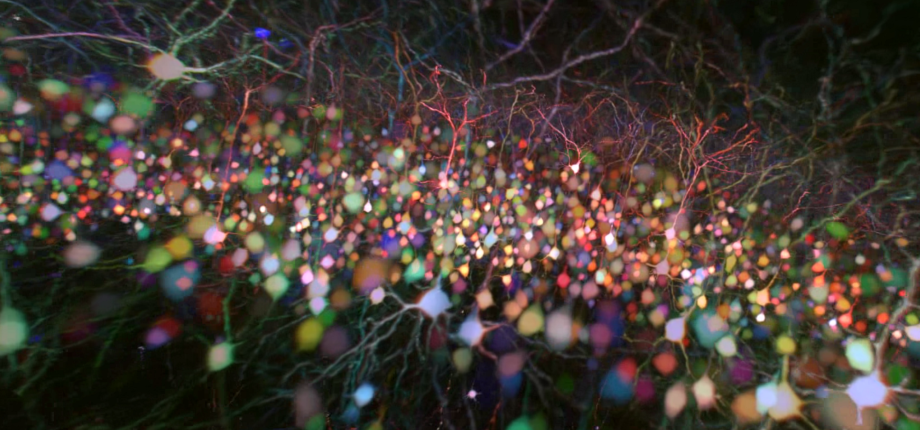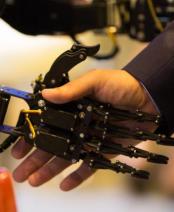Multi-photon microscopy...and many facets

Emmanuel Beaurepaire, CNRS Research Director at the Laboratory for Optics and Biosciences (LOB) at École Polytechnique, works at the frontier between physics and life sciences. Several hundred micrometers from the surface of biological tissues, the researcher scrutinizes the morphology and functioning of cells with micrometric resolution (editor's note: a cell measures a few tens of micrometers). To this end, he has developed a tool in which the LOB Advanced Microscopies team has become a specialist: the multi-photon microscope.
Non-invasive, this imaging technique preserves tissues and, in some cases, enables in vivo observations. “It appeared in the 90s, in the wake of very short-pulse lasers (femtoseconds, 10-15s). A pulsed beam of infrared light targets the sample. At the focal point, i.e. in a very small volume, a fraction of the beam is converted and re-emitted into visible light, characteristic of the photophysical properties of the tissue observed”, explains Emmanuel Beaurepaire. By scanning the focal point in 2D or 3D, scientists are able to produce highly detailed images containing valuable information not observable with conventional microscopy. “To understand these signals, however, we need to study how they manifest themselves in tissues and cells. We also need to build numerical models that will enable us to deduce relevant biological parameters”.
Multi-photon microscopy offers a wide range of contrasts and applications in the life sciences. For example, the fluorescence naturally present in certain tissues, or introduced genetically, has been an asset in the study of neurogenesis and brain cell lines (Brainbow labeling - See focus on Brainbow labeling). It is also an excellent marker of the metabolic state of cells, and therefore an indicator of their healthy or pathological evolution.
Between fundamental and applied research
“This property is of particular interest to us in the study of certain neurodegenerative diseases linked to myelin production”, stresses the researcher. As part of a collaboration with the Institut du cerveau et de la moëlle épinière (ICM**), the “Advanced Microscopies” team uses fluorescence to probe the metabolic state of myelin-producing cells. At the same time, a specific multi-photon microscopy signal - Third Harmonic Generation (THG) - enables the team to characterize its distribution in nerve tissue. “THG differentiates media according to their refractive indices. It can therefore be used to map myelin distribution on scales ranging from micrometers to centimeters in samples of healthy and pathological tissue. Superimpose these observations on data obtained by fluorescence and you can study the link between myelin and cellular metabolism”, enthuses the researcher. The potential of third harmonic generation has yet to be fully realized. In the course of their work, the scientists observed that it could specifically reveal red blood cells and their oxygenation levels. This fortuitous discovery opens the way to a better understanding of functional MRI images, based on the link between cerebral activity and neuronal oxygenation.
“Multi-photon microscopy is at the crossroads of fundamental and applied research. Thanks to it, we have a better understanding of the mechanics of certain pathologies, and are regularly exploring new opportunities". For example, another signal called Second Harmonic Generation (SHG) provides information on the structure of collagen, an essential component of the extracellular matrix. In ophthalmology, the lamellar organization of this protein contributes to the transparency of the cornea. Marie-Claire Schanne-Klein's group at LOB's microscopy unit has demonstrated how SHG can be used to map these structures in detail, and identify the disorganization that distorts the tissue and makes it opaque. In certain gynaecological cancers, the same signal reveals the distribution of collagen in the extracellular matrix and the links with tumour progression. It is also used in certain model organisms to observe the distribution of myofilaments during heart development.
Challenges ahead
“We have acquired expertise in the field of multi-photon microscopy, and technical challenges lie ahead to optimize microscopes: miniaturizing them to image mouse brains at work, increasing image acquisition speed to study cardiac tissue contractions, imaging at greater depths (greater than a millimeter)...”. Finally, a major challenge is emerging in data management. Increasingly detailed and numerous, images deliver a vast amount of information to be processed and analyzed. “Today, for example, we can map an entire mouse brain with cellular resolution. It's a colossal data set! Artificial intelligence, via Machine Learning, is an invaluable ally in detecting millions of cells in an image, then analyzing and interpreting the numerous measurements extracted from the data”, concludes the researcher.
About Emmanuel Beaurepaire
Emmanuel Beaurepaire is a physicist by training and a specialist in multiphoton microscopy of biological tissues at the Institut Polytechnique de Paris. He works at the Laboratory for Optics and Biosciences at École Polytechnique, where he was appointed CNRS Research Director.
*LOB : a joint research unit CNRS, Inserm, École Polytechnique, Institut Polytechnique de Paris, 91120 Palaiseau, France
** ICM : Sorbonne Université, Inserm, CNRS, AP-HP














